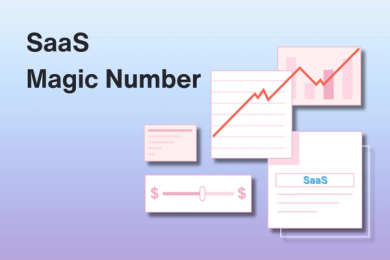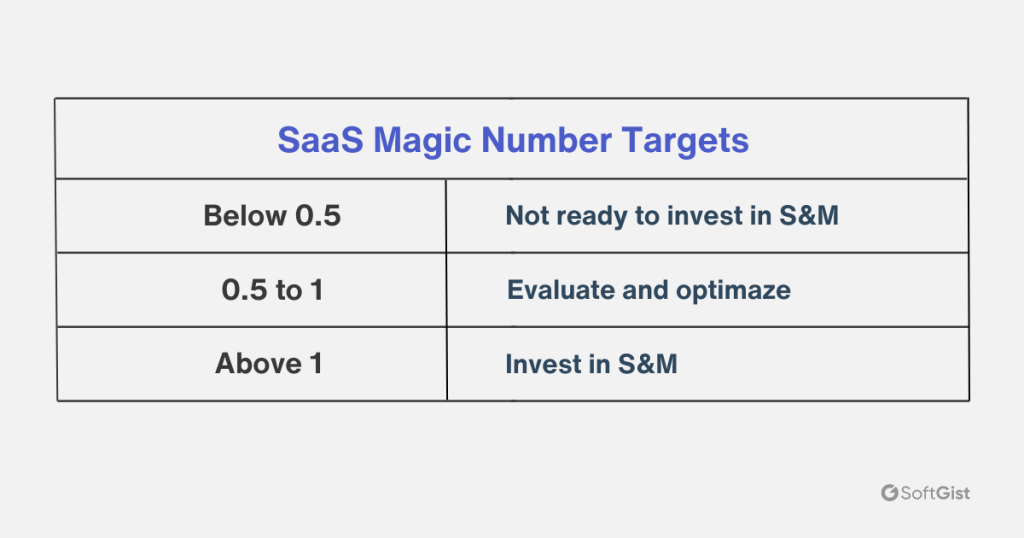SaaS Magic Number: A Complete Guide
Updated May 28, 2024
Published July 28, 2023

The SaaS Magic Number is a powerful metric that measures the sales and marketing efficiency of software subscription businesses.
This article explores what the Magic Number is, how to interpret it, strategies to improve it, its limitations, and complementary metrics that provide a more complete picture. Understanding and optimizing the SaaS Magic Number within the context of other key SaaS metrics enables data-driven decisions to boost growth.
What is the SaaS Magic Number?
The SaaS Magic Number is a metric that measures how efficient a software subscription business is at generating revenue from its sales and marketing efforts.
It calculates the ratio between the new recurring revenue gained in the current quarter and the total spent on marketing in the previous quarter.
Essentially, it answers the question:
How much recurring revenue is made for the company for every $1 spent to get new customers?
The formula is:

Recurring revenue refers to the steady income a SaaS company receives from subscriptions each month.
A Magic Number of 1 or above is good. This means $1 or more in recurring revenue was generated for each $1 spent on marketing.
A number below 1 means the marketing spend is not yet paying for itself through new revenue. A very high number could mean the company is underspending on marketing.
The Magic Number shows how well sales and marketing efforts are working. SaaS companies can use it to make decisions on optimizing marketing costs, increasing revenue, and improving sales processes.
However, it has limitations. It doesn’t fully describe a company’s overall health. It works best when used along with other metrics for a more complete picture. But it remains a simple and useful way to gauge sales and marketing efficiency.
Interpreting Your SaaS Magic Number
The Magic Number shows how efficiently your sales and marketing efforts generate recurring revenue from new customers. But interpreting it takes some analysis beyond looking at whether it is above or below 1.

A number much higher than 1 could mean you are under-investing in marketing and sales. You may be able to grow faster by spending more in those areas.
A number close to 1 suggests your sales and marketing spend is in a healthy balance with revenue generated. But you still need to keep optimizing strategies to maintain that balance as the business evolves.
A number below 1 indicates your sales and marketing efforts are not yet efficient enough. This could mean you need to improve strategies, train sales teams better, or reduce spending on ineffective channels.
A number below 0.5 indicates your sales and marketing efforts are significantly inefficient at generating recurring revenue from new customers. In other words, you are spending more on marketing and sales than the revenue being produced from those efforts.
The Magic Number also needs context. For a young startup, a number below 1 could be acceptable in the short term if they are focused on growth. For a mature company, that may signal something needs to change.
Some additional tips on interpreting your number:
- Consider how it fluctuates over time rather than just looking at one quarter. Trends matter.
- Factor in other metrics like profit margins and customer lifetime value as well for a complete picture.
- Set targets based on your specific business situation and goals. There is no one-size-fits-all “good” number.
The SaaS Magic Number is a powerful tool but needs thorough analysis. Look at trends over time, your unique context, and other metrics to make informed decisions based on what it tells you.
How to Improve Your SaaS Magic Number
There are several strategies SaaS companies can implement to enhance their Magic Number, which reflects sales and marketing efficiency.
Refine Customer Acquisition Strategy
Optimizing customer acquisition requires scrutinizing your sales funnel and marketing channels to find and fix inefficiencies. Identify drop-off points and simplify friction areas to smooth the path to conversion. Assess channel performance and shift budget to high-ROI sources.
It’s also key to segment your audience and personalize messaging based on research into their needs and pain points in the customer journey. Tailored content that addresses audience challenges establishes your brand as a trusted resource.
Boost Customer Retention and Loyalty
Boosting retention and loyalty increases recurring revenue and your SaaS Magic Number. Deliver exceptional onboarding to set users up for success. Maintain robust support channels, so help is always accessible. Monitor satisfaction closely. Solicit regular feedback and act on suggestions to improve the user experience. Enable self-service through educational content. Proactively engage with customers to maximize value realization.
Increase Recurring Revenue with Upsells and Cross-sells
Upselling and cross-selling to existing customers is an efficient way to increase recurring revenue and improve your SaaS Magic Number. Analyze usage data to identify opportunities to upsell higher tiers with more features. Highlight promotional offers to incentivize upgrades. Look for chances to cross-sell complementary offerings like add-ons to current customers. Educate customers on the full scope of solutions to uncover expansion possibilities.
Optimize Marketing Spend
Take time to analyze the return on investment (ROI) of your various marketing initiatives and channels. Look at performance data to identify any underperforming efforts that may represent an inefficient use of budget. Consider decreasing or eliminating spending in those areas.
On the flip side, determine which marketing activities, partnerships, and channels are driving the highest conversion rates and providing the best bang for your buck. Shift more budget towards those high-performing, high-ROI initiatives to maximize results.
Additionally, negotiate with vendors, platforms, and partners to get better ad rates, referral program terms, or other cost improvements. Savings from better deals can be reinvested into initiatives proven to work.
Enhance Sales Team Productivity
Boosting sales team productivity can directly impact revenue growth. Consider providing reps with additional training on your product, competitors, common objections, and closing techniques through roleplaying and workshops. Equip them with sales enablement tools like templated emails, presentation decks, and proposal generators to work more efficiently.
Look at existing sales processes to identify any friction points or bottlenecks slowing down deals. Develop standardized systems, documents, and workflows to smooth the path from lead to closed sale.
Implement competitions, spiffs, and performance incentives to motivate the team to hit and exceed targets. Publicly recognize top performers.
The more you can arm sales reps with relevant knowledge, efficient systems, and motivation to succeed, the more productivity and closed deals you can expect.
Continuously Analyze and Iterate
Regularly monitor key metrics to spot trends and opportunities to optimize growth strategies. Run controlled experiments to test new approaches. Learn from both successes and failures to determine what’s working and what’s not. Use data and insights to continuously refine efforts over time. Continued analysis, testing, and refinement are key to driving substantial revenue growth.
Limitations of SaaS Magic Number
The SaaS Magic Number is a lagging indicator that reflects past performance rather than predicting future results. While it provides insight into previous sales and marketing efficiency, it doesn’t necessarily indicate how future investments will pan out.
It focuses solely on new revenue generated and doesn’t account for the quality or profitability of customers acquired. Attracting many low-value customers could temporarily inflate the number but not support long-term sustainable growth.
The metric does not consider customer lifetime value or the total revenue a customer will generate over time. Strategies involving higher upfront acquisition costs for valuable, long-term customers may temporarily depress the number.
The Magic Number is most applicable for subscription-based SaaS businesses and may not be as relevant for companies with different business or pricing models.
It only examines sales and marketing costs without accounting for other expenses like onboarding, support, and infrastructure costs related to new customers.
External factors like market conditions, competition, and economic trends can influence the number but are out of a company’s control.
Given these limitations, the SaaS Magic Number should be viewed as one tool among many other sales efficiency metrics for assessing business performance. It provides a useful but incomplete perspective, so should be considered alongside other metrics like CLV, churn, CAC, and NPS to make informed decisions.
Complementary SaaS Metrics
To address the limitations of the SaaS Magic Number discussed in the previous section, the number should be tracked alongside other key SaaS metrics that provide additional perspectives. Here are the key complementary metrics that should be tracked together:
- Monthly Recurring Revenue (MRR) – Total recurring subscription revenue in a month. Helps track revenue stability and growth over time. Important for forecasting cash flows and future revenue potential.
- Customer Acquisition Cost (CAC) – The average cost of acquiring a new customer across sales, marketing, etc. Monitor CAC to evaluate marketing efficiency. A low CAC means cheaper customer acquisition. Compare CAC to CLV to ensure profitability.
- Customer Lifetime Value (LTV) – Total revenue a customer generates over their lifetime. Compare LTV and CAC to assess the profitability of customer acquisition efforts and determine sustainable marketing spend. High LTV means you can justify higher upfront acquisition costs.
- Churn Rate – Percentage of customers canceling subscriptions in a period. High churn indicates dissatisfaction and threatens revenue retention. Reducing churn is key for maintaining and growing a healthy customer base long-term.
- Net Revenue Retention (NRR) – Revenue changes from existing customers considering upgrades, downgrades, and churn. High NRR signals revenue growth from current customers without new acquisitions. Allows evaluating expansion efforts.
Tracking these metrics together with the Magic Number provides a comprehensive view of overall business performance to optimize strategies. Each metric offers unique and actionable insights.
Conclusion
The SaaS Magic Number offers valuable insight into sales and marketing efficiency. But it has limitations and should be tracked alongside metrics like MRR, CAC, LTV, and churn rate.
Optimizing the Magic Number requires strategies like refining customer acquisition, boosting retention, increasing recurring revenue, and enhancing sales team productivity. Regular analysis, iteration, and tracking of complementary metrics give a more complete view.
For SaaS businesses, the Magic Number is a powerful lever to drive growth when interpreted within the context of other performance indicators. Master this metric, but view it as one piece of the puzzle.
Frequently Asked Questions
Share This Post
Ada Rivers
Ada Rivers is a senior writer and marketer with a Master’s in Global Marketing. She enjoys helping businesses reach their audience. In her free time, she likes hiking, cooking, and practicing yoga.
Allow cookies
This website uses cookies to enhance the user experience and for essential analytics purposes. By continuing to use the site, you agree to our use of cookies.
